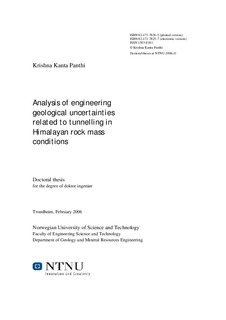| dc.description.abstract | The need for tunnelling in Nepal, as in the Himalayan region in general, is enormous, particularly for hydropower development. Due to active tectonic movement and dynamic monsoon, the rock mass in the Himalaya is relatively weak and highly deformed, schistose, weathered and altered. Predicting rock mass quality, analyzing stress induced problems, in particular tunnel squeezing, and predicting inflow and leakage often have been found extremely difficult during planning stage. Considerable discrepancies have been found between predicted and actual rock mass conditions, resulting in significant cost and time overrun for most of the tunnelling projects. Finding innovative solutions for quantifying geological uncertainties and assessing risk are therefore key factors for cost effective and optimum future tunnelling through Himalayan rock mass.
In this thesis, a probabilistic approach of uncertainty analyses has been introduced to deal with the most important geological uncertainties reflecting Himalayan rock mass conditions. A geological uncertainty analysis model concept based on the software program @Risk has been applied for this purpose.
The analyses presented in this thesis are based mainly on four headrace tunnel cases from Nepal; 1) 60 MW Khimti I hydropower project, 2) 144 MW Kaligandaki “A” hydroelectric project, 3) 14 MW Modi Khola hydroelectric project, and 4) 69 MW Middle Marsyangdi hydroelectric project. The first three projects have been completed recently and the fourth one is under construction.
The thesis identifies the most crucial aspects of tunnel stability problems (geological uncertainties) by reviewing the engineering geological conditions of the respective cases and the Himalayan geology. It also evaluates the theoretical aspects of the main factors influencing on tunnel stability, reviews the engineering geological conditions, the extent of pre-construction phase engineering geological investigations, evaluates the deviation between predicted and actual rock mass conditions, and describes the laboratory testing that has been carried out for the respective cases. Probabilistic approaches that have been applied in the field of engineering geology in past and the basic theory on statistical analyses are briefly discussed. Main emphasis is then placed on the descriptions of useful probability distribution functions (pdf), the @Risk statistical analysis tool, the applied uncertainty analysis model concept and @Risk analysis for the respective tunnel cases.
The uncertainty analyses include rock mass quality evaluation based on the Q-system of rock mass classification for Khimti and Modi Khola headrace tunnels, tunnel squeezing based on Hoek and Marinos approach for Kaligandaki and Middle Marsyangdi headrace tunnels, and finally analysis of water leakage from the Khimti headrace tunnel. The degree of correlation between simulated results achieved by the @Risk model and values actually measured in the tunnel is discussed and the sensitiveness and effect of variations in the value of each input parameter and sensitivity of equations and methods used to analyze geological uncertainties are evaluated.
It is concluded that the proposed uncertainty analysis approach gives very promising results and has a great potential for analyzing tunnel projects in the Himalayan rock mass conditions, but more cases are needed for conforming the reliability of the methodology. | nb_NO |
